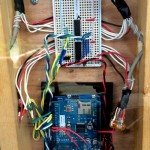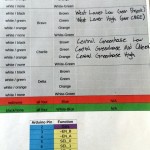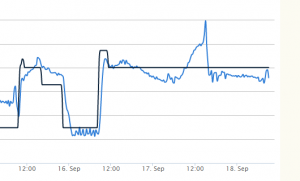What can we learn from this amazing building we inhabit, and what is it trying to tell us? Thanks to last year’s Living Building class and our Engineer in Residence, Richard Lange, we have an abundance of sensors all around the Commons constantly reporting back data to our Commons Control system. Using Arduino-based sensors (Arduino is an open-source electronics platform based on easy-to-use hardware and software), our students can look at the big picture of how the systems interact or can pinpoint one energy system and evaluate the data generated within specific time periods for comparison.
- The color-coded set of sensors from the solar chimneys
- How each color relates to a specific location
- The live data site which also allows students to reference archived data
This year, the Living Building class is digging into some interesting sets of data and raising questions about what they mean. An example is this graph of the temperature in the solar chimneys–east and west, both with sensors reporting temperatures from the bottom and the top of the chimneys. For structures that are approximately 30 feet high, there is often a temperature variation of 30 degrees from the bottom of a chimney to the top. This has remarkable application for when we begin to use the passive venting of the air in the solar chimneys to heat the various rooms in the colder months of the year.
You can see the pattern that develops within the east chimney during the course of each day.
No matter where you look, questions are raised from the collected data. For instance, one quick look at the difference between Set Temperature for the Briggs Center for Civic Engagement and the Actual Temperature around lunchtime on Wednesday shows a strange spike in actual temperature.
What caused this? Who was in the room? Did someone open the solar chimney to introduce hot air into the room? A nearly infinite number of questions driven by these data await our students and all who inhabit the Commons. We have much to learn from the building about how to operate it efficiently and sustainably!




